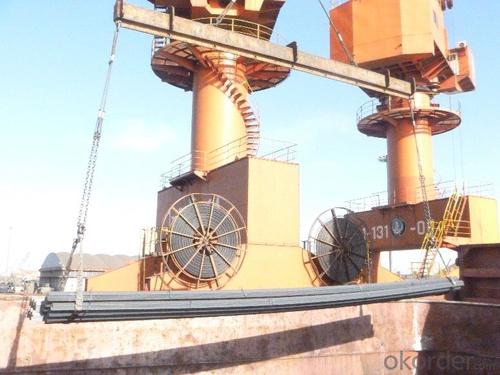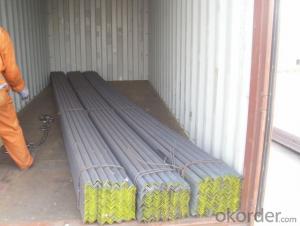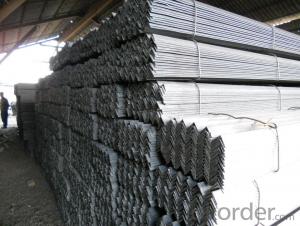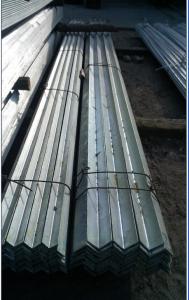GB Q235 Equal Steel Angle
OKorder Service Pledge
OKorder Financial Service
You Might Also Like
Specifications of Equal Angle Steel
1.Standards:GB
2.Length:6m,9m,12m
3.Material:GBQ235,Q345 or Equivalent
4. Size:
Size (mm) | Mass (mm) | Size (mm) | Mass (mm) |
| 25*25*2.5 | 0.95 | 25*25*3 | 1.124 |
| 25*25*2.7 | 1.02 | 25*25*4 | 1.459 |
Usage & Applications of Equal Anlge Steel
Trusses;
Transmission towers;
Telecommunication towers;
Bracing for general structures;
Stiffeners in structural use.
Packaging & Delivery of Equal Angle Steel
1. Transportation: the goods are delivered by truck from mill to loading port, the maximum quantity can be loaded is around 40MTs by each truck. If the order quantity cannot reach the full truck loaded, the transportation cost per ton will be little higher than full load.
2. With bundles and load in 20 feet/40 feet container, or by bulk cargo, also we could do as customer's request.
3. Marks:
Color mark: There will be color marking on both end of the bundle for the cargo delivered by bulk vessel. That makes it easily to distinguish at the destination port.
Tag mark: There will be tag mark tied up on the bundles. The information usually including supplier logo and name, product name, made in China, shipping marks and other information request by the customer.
If loading by container the marking is not needed, but we will prepare it as customer request.
*If you would like to get our price, please inform us the size, standard/material and quantity. Thank you very much for your attention.
- Q: Can steel angles be customized or fabricated to specific requirements?
- Yes, steel angles can be customized or fabricated to specific requirements.
- Q: How many kilograms per square meter is angle steel 63*63*6?
- Angle gaugeCalculation method of angle weight:Weight per meter =0.00785* (edge width + edge width - side thickness) * edge thicknessEquilateral angle steel, kg/m equal angle steel, kg/m equal angle steel, kg/m25*3 1.124, 70*8 8.373, 110*12 19.78225*4 1.459, 75*5 5.818, 110*14 22.80930*3 1.373, 75*6 6.905, 120*10 18.20030*4 1.786, 75*7 7.976, 120*12 21.60040*3 1.852, 75*8 9.030, 125*8 15.504
- Q: How do you cut steel angles to size?
- To achieve the desired size for steel angles, one can employ various techniques depending on the available tools. Here are a few commonly used methods: 1. Angle Grinder Method: A versatile tool, the angle grinder, can be utilized for cutting steel angles. Make sure to attach a cutting disc suitable for metal cutting to the grinder. Mark the desired length on the angle and securely clamp it down. Carefully follow the marked line using the grinder, applying even pressure to cut through the steel. Remember to take necessary safety precautions, such as wearing protective eyewear and gloves, and remain cautious of any sparks produced during the cutting process. 2. Bandsaw Technique: If a bandsaw is accessible, it can be an efficient tool for cutting steel angles. Ensure that the bandsaw is equipped with a blade specifically designed for metal cutting. Securely clamp the angle, aligning the marked line with the path of the blade. Start the bandsaw and gradually feed the angle into the blade, maintaining a steady pace to achieve a clean cut. 3. Hacksaw Approach: Although a slower method, a hacksaw can also be employed for cutting steel angles. Begin by securely clamping the angle to a workbench or vise. Use a square to mark a straight cutting line on the angle, then carefully saw along the line. Apply steady pressure while sawing to maintain control and achieve a clean cut. Remember to use a blade suitable for cutting metal and take breaks if necessary to avoid fatigue. Regardless of the chosen method, it is crucial to prioritize safety precautions, such as wearing appropriate protective gear and ensuring a clear and well-ventilated work area. Furthermore, always double-check measurements and utilize proper techniques to achieve accurate cuts.
- Q: What is the maximum temperature steel angles can withstand?
- The specific grade of steel being used determines the maximum temperature that steel angles can endure. In general, carbon steel can withstand temperatures of approximately 1000°C (1832°F) before its structural integrity begins to deteriorate. Nonetheless, the duration of exposure to high temperatures, the applied load, and the cooling rate after exposure are also influential in establishing the maximum temperature that steel angles can tolerate. To ensure that the steel angles are used within their safe temperature limits, it is advisable to consult the manufacturer's specifications or a structural engineer.
- Q: Can steel angles be used in the construction of industrial chimneys?
- Yes, steel angles can be used in the construction of industrial chimneys. Steel angles are commonly used as structural components in various construction projects due to their strength, durability, and versatility. In the case of industrial chimneys, steel angles can be used to provide support and stability to the chimney structure. They can be incorporated into the design to reinforce the chimney's framework, particularly at the corners and joints where additional strength is required. Additionally, steel angles can also be used to create a base or foundation for the chimney, ensuring stability and preventing any potential structural issues. Overall, steel angles are a suitable choice for the construction of industrial chimneys due to their ability to withstand the high temperatures and harsh conditions associated with chimney operation.
- Q: Are steel angles resistant to impact?
- Steel angles are known for their exceptional strength and durability, which makes them highly resistant to impact. Due to their structural design and composition, steel angles can withstand significant forces without deforming or breaking. This resistance to impact is attributed to the hardness and toughness of steel, allowing it to absorb and dissipate energy from external forces. Additionally, steel angles can be further reinforced or coated to enhance their impact resistance, making them a popular choice in various applications such as construction, automotive manufacturing, and industrial machinery. However, it is essential to note that the impact resistance of steel angles can vary depending on factors such as the specific grade of steel used, the angle's dimensions, and the manner in which it is installed or utilized.
- Q: Can steel angles be used for framing partitions and walls?
- Yes, steel angles can be used for framing partitions and walls. Steel angles are commonly used in construction for their strength and durability. They can be used to create a framework for partitions and walls by providing structural support and stability. Steel angles are versatile and can be easily cut and welded to fit the desired dimensions and angles. They are also resistant to fire, pests, and moisture, making them a suitable choice for framing interior walls and partitions in both commercial and residential buildings.
- Q: How do you determine the required number of steel angles for a project?
- Determining the necessary quantity of steel angles for a project involves taking into account several factors. First and foremost, it is crucial to comprehend the project's design and specifications. This encompasses the structural prerequisites, load-bearing capacities, and any specific angles or dimensions that must be incorporated. Subsequently, the dimensions of the steel angles need to be ascertained based on the intended utilization and structural prerequisites. This entails considering the suitable length, width, and thickness of the angles for the project. Once the dimensions are established, the subsequent step involves calculating the requisite number of angles. This can be accomplished by meticulously measuring and estimating the lengths of the steel angles required in each area of the project. It is important to take into account any potential waste or additional cuts that might be necessary during the installation process. Furthermore, it is advisable to seek advice from structural engineers or professionals well-versed in steel fabrication to ensure precise calculations and to confirm that the chosen steel angles fulfill the necessary safety standards and building codes. Ultimately, determining the necessary quantity of steel angles for a project necessitates a combination of meticulous planning, accurate measurements, and professional expertise to guarantee that the project is structurally sound and meets all the necessary requirements.
- Q: What is the process of cold bending steel angles?
- Manipulating steel angles into a desired shape without using heat is the process of cold bending. This involves applying force or pressure to the angles in a controlled manner. To begin, a bending machine or fixture securely holds the steel angle in place during bending. The operator then determines the desired angle and bend radius, which dictate the required force. Subsequently, pressure is gradually applied by the bending machine or fixture to bend the steel angle to the desired shape. This force is applied slowly and evenly to prevent any deformation or damage. Throughout the bending process, it is crucial to monitor the angle and ensure even and smooth bending. Adjustments to the pressure or angle may be necessary to achieve the desired shape. Once the steel angle has been bent to the desired angle, it is cautiously removed from the bending machine or fixture to prevent any distortion or damage. Cold bending steel angles have various advantages over hot bending, including reduced risk of material distortion or weakening caused by heat. It also allows for more precise and controlled bending, making it ideal for applications where accuracy is vital. In conclusion, cold bending steel angles involves securely positioning the angle in a bending machine or fixture, applying gradual and controlled pressure to bend it to the desired shape, and carefully removing the bent angle for further use.
- Q: Can steel angles be used for manufacturing window frames?
- Yes, steel angles can be used for manufacturing window frames. Steel angles are commonly used in construction and fabrication due to their strength and durability. They provide structural support and can be easily welded or bolted together to create window frames that are sturdy and long-lasting.
Send your message to us
GB Q235 Equal Steel Angle
OKorder Service Pledge
OKorder Financial Service
Similar products
Hot products
Hot Searches
Related keywords



























